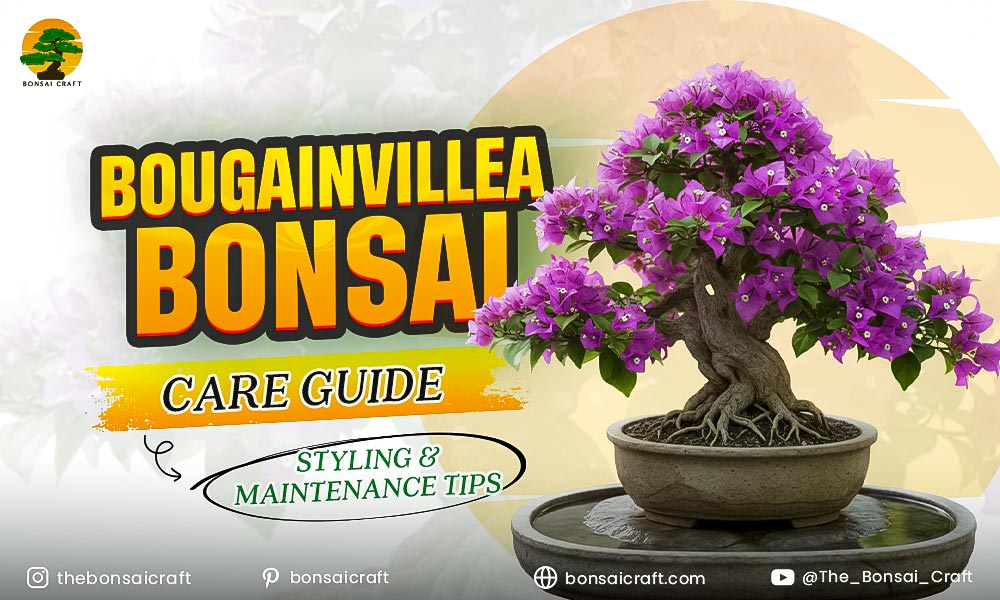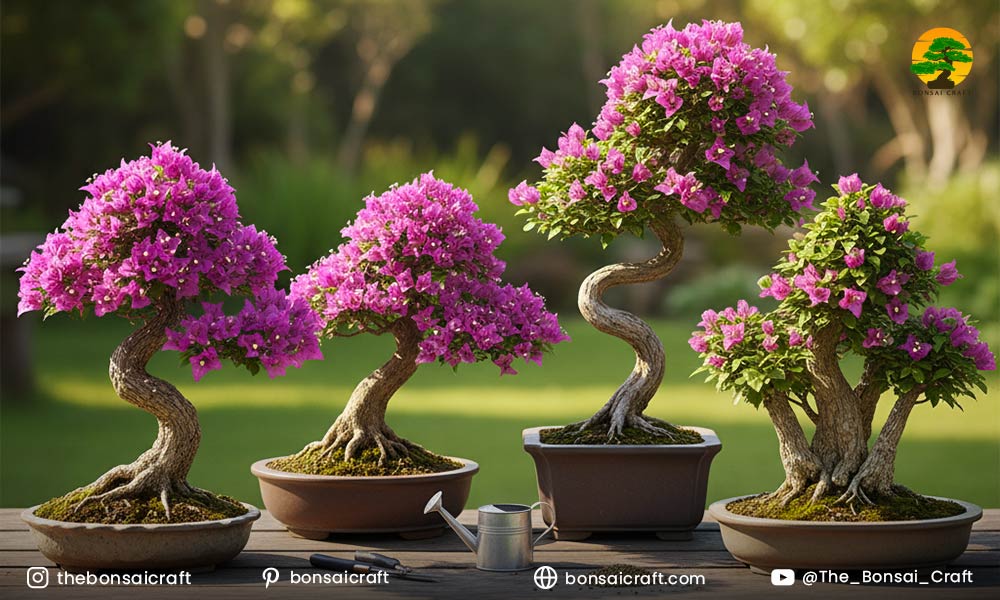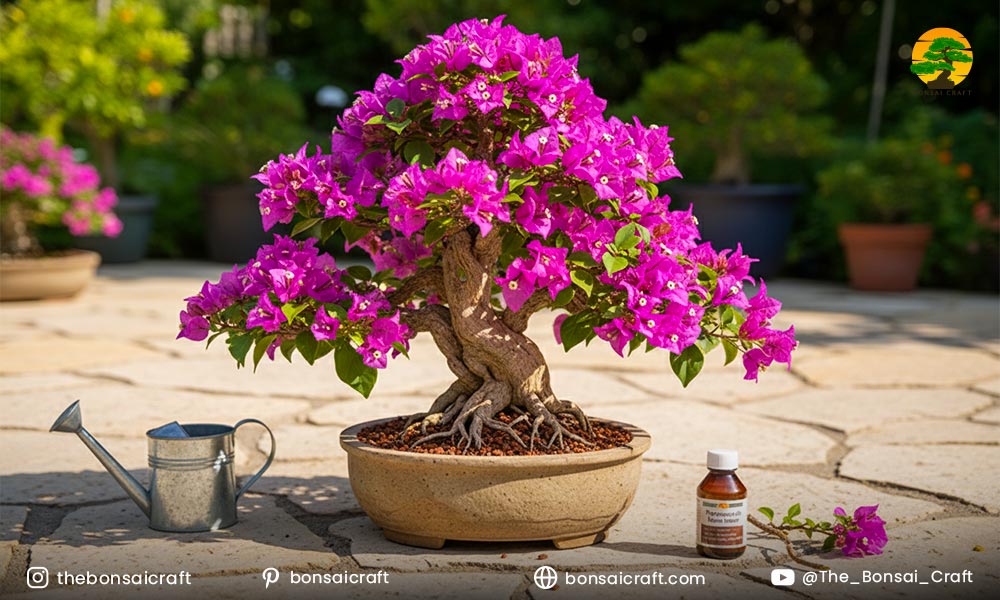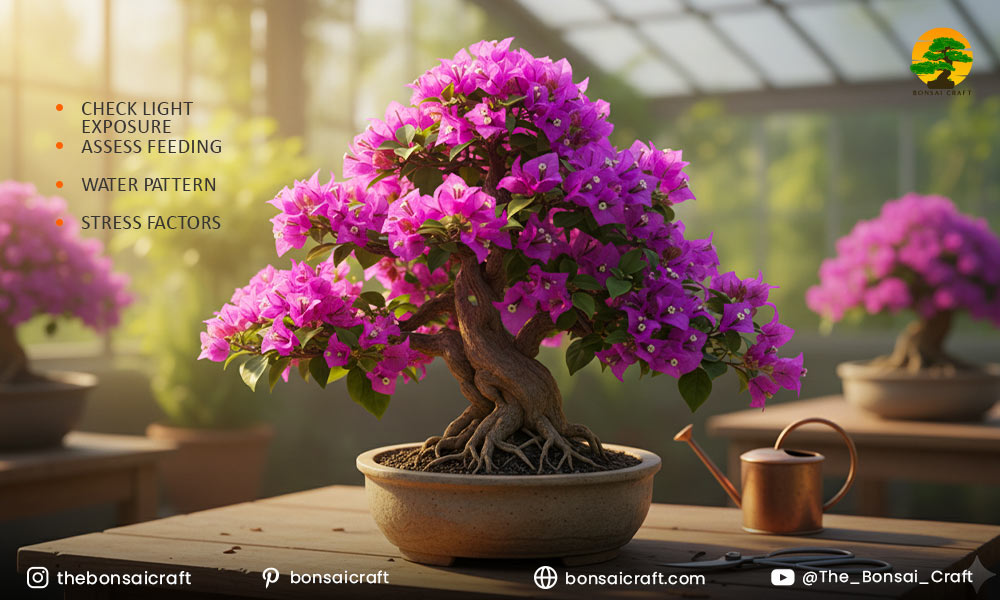
The bougainvillea bonsai is a striking, colorful miniature that brings tropical flair to terraces, patios, and indoor displays. Its vivid bracts, vigorous growth, and tolerance for heavy pruning make bonsai bougainvillea a favorite among enthusiasts who want fast visual results. I’ve trained and maintained bougainvillea bonsai trees for years, experimenting with styling, propagation, and seasonal care; this guide collects proven, experience-backed advice to help you grow a healthy, flowering specimen.

What are the essential conditions for bougainvillea bonsai care?
Bougainvillea bonsai care requires full sun (5–6 hours daily), fast-draining soil, warm temperatures (60°F–95°F), and a “soak-and-dry” watering approach. Consistent pruning and periodic repotting keep the plant compact and flowering.
Detailed Explanation:
- Light: To promote bract flowering, the tree needs consistent and direct sunlight, and failure to provide this will lead to leggy growth and sparse blooming.
- Soil: To avoid root rot, use a bonsai soil mix that is gritty and well-draining (akadama and pumice, lava rock, or coarse sand).
- Water: Water should be applied thoroughly to the point of soil drainage, after which the topsoil should be allowed to dry slightly. Overwatering will result in reduced flowering, and slight drought conditions will increase flowering.
- Temperature: Bougainvillea is susceptible to frost, so during cold periods, indoor bonsai should be protected.
- Feeding: Bougainvillea will show increased bract production when fed a balanced fertilizer during growth periods, and one that is higher in phosphorus prior to blooming.
How to grow bougainvillea bonsai from seed or cutting?
Starting bougainvillea bonsai from seed is an option; however, it is a long process. Using cuttings is more efficient. To take a cutting, use semi-hardwood. It should be several inches long, roughly 6 to 8 inches. Apply rooting hormone and let it root in a sandy mix under high humidity. It will take 1 to 3 years to create bonsai material.
Detailed Explanation:
- Seeds: Place them in water for one night to soak. Sow them in a light seed mix and provide warmth for them to grow. Germination will take a longer time and the plant will have varying characteristics.
- Cuttings: The best time to take cuttings is in spring. Remove the lower leaves, place rooting hormone on the cut end, and put them in perlite/peat or sand. The cuttings will grow roots in 4 to 6 weeks. Cover them with a humidity dome.
- Transplanting: Move rooted plants to training pots and begin basic structure pruning once stems thicken.
When to repot bougainvillea bonsai?
Repot bougainvillea bonsai every 2–3 years in early spring before new growth. Trim up to 25% of the roots, refresh soil, and check for root health.
Detailed Explanation:
- Why repot: Refreshes nutrients and prevents root-binding.
- How to repot: Remove tree, comb roots, trim circling and long roots, position in pot with fresh gritty mix, anchor with wire, and water thoroughly. Keep shaded for 1–2 weeks to recover.

How often should you water and fertilize a bougainvillea bonsai?
Water when the top 1–2 inches of soil are dry—soak thoroughly and allow partial drying. Fertilize every 10–14 days in spring/summer with a balanced feed; switch to a phosphorus-rich formula before flowering.
Detailed Explanation:
- Watering rhythm: Adjust for climate—daily in hot summers, less in cooler weather.
- Fertilizer tips: Avoid excess nitrogen late in the season (promotes leaf growth at the expense of flowers). Organic options like fish emulsion work well.
How to prune bougainvillea bonsai for shape and blooms?
Prune right after flowering cycles, cutting back to 2–3 nodes to promote branching and more bracts. Structural pruning is done in late winter; maintenance pruning is ongoing during growth.
Detailed Explanation:
- Maintenance pruning: Pinch or snip new shoots frequently to keep compact ramification.
- Structural pruning: Remove heavy limbs and rebalance the canopy in the dormant season.
- Flower pruning: Deadhead spent bracts and prune to encourage multiple blooming flushes.
What are the best bonsai styles for bougainvillea?
Cascade (Kengai), Semi-cascade (Han-Kengai), informal upright (Moyogi), and multi-trunk styles suit bougainvillea, highlighting cascading stems and vibrant bracts.
Detailed Explanation:
- Cascade: Emphasizes trailing growth; choose a specimen with flexible branches and a strong trunk.
- Semi-cascade: Allows partial downward movement without full inversion.
- Informal upright: Natural, informal shapes showcase colourful canopy.
- Multi-trunk: Plant several cuttings in a larger tray to simulate an old clump.
Soil, Pot and Root Care
A gritty mix improves oxygenation and avoids saturation. Choose a pot with adequate drainage; shallow bonsai pots accentuate form, but allow enough root volume for blooms. When root pruning, remove old tangled roots and favor finer feeder roots for nutrient uptake.
Wiring and Training Techniques
Bougainvillea branches are brittle. Wire gently using aluminum wire, avoid tight wraps, and check wire frequently. Use clip-and-grow where possible—train direction by selective pruning and tying branches with raffia or soft ties to reduce scarring risk.
Seasonal Care Guide for Bougainvillea Bonsai
- Spring: Repot if needed; start feeding; prune before flowering starts.
- Summer: Daily watering in hot climates; frequent feeding to support blooms; pinch back shoots to maintain shape.
- Fall: Reduce watering frequency; switch fertilizer to balanced or phosphorus-rich mix; protect from early frost.
- Winter: Bring indoors if temperatures drop; minimal watering (soil should not stay soggy); no major pruning—let the tree rest.
How to grow bougainvillea bonsai from seed (step-by-step)
While most enthusiasts prefer cuttings for faster growth, you can grow bougainvillea bonsai from seed with patience:
- Collect seeds from dried pods.
- Soak overnight in warm water.
- Sow in a seed tray with bonsai soil.
- Keep warm (70–80°F) and moist until germination.
- Transplant seedlings after 6–8 months into small pots; shape after 2–3 years.
Propagation by Cuttings (Faster Method)
- Take semi-hardwood cuttings (6–8 inches) in spring.
- Dip in rooting hormone and plant in a sandy mix.
- Keep in high humidity until roots develop (4–6 weeks).
- Transfer to bonsai pots once established.
In-depth Pruning Techniques (Cuts, Timing, and Healing)
Pruning is more than cutting—it’s sculpting. Make clean cuts just above an outward-facing node or bud to promote outward growth and prevent inward branches. For larger branch removals, use a three-cut method: (1) undercut about 1–2 inches from the trunk to prevent bark tear, (2) cut the branch tip off beyond the undercut, (3) make the final cut close to trunk with a concave cutter to encourage smooth callusing. Disinfect tools with isopropyl alcohol or a dilute bleach solution between cuts. After big cuts, avoid heavy feeding until the wound begins to callus.
Wiring: Gauges, Timing, and Protection
Choose a wire size proportional to the branch thickness—1.0–2.5 mm aluminum for small bougainvillea branches. Start wiring in late spring when branches are slightly pliable; wrap the wire at a 45-degree angle and avoid overlapping too tightly. Protect thin bark with raffia or tape under the wire, especially where you apply bends. Monitor wired areas every 2–4 weeks; remove the wire promptly if it starts to bite into the bark. If a branch resists bending, use gradual bends over weeks rather than forceful snaps.
Detailed Repotting Walkthrough
- Preparation: Soak the new soil mix and have the mesh and wire ready for the drainage holes.
- Removal: Gently ease the tree from its pot, minimizing root breakage.
- Root cleaning: Use a root rake to comb out old soil and inspect for rot or girdling roots.
- Root pruning: Trim long, thick roots and leave a fibrous root mass. Aim to remove up to 25% of root volume for mature plants.
- Stabilizing and potting: Place the tree at the desired angle, secure with wire through drainage holes, backfill with soil, and water slowly until evenly moist.
- Post-repot care: Keep the tree in partial shade, avoid heavy feeding, and monitor daily for transplant shock.
Fertilizer Schedule and Recipes
A practical feeding rhythm for bougainvillea bonsai care:
- Early spring: Start with a balanced liquid fertilizer (10-10-10) weekly for four weeks.
- Pre-bloom (late spring): Apply a phosphorus-rich feed (10-30-10) every 10–14 days for 6 weeks.
- Summer: Alternate balanced feeds with trace element supplements; foliar feeding early morning helps in heat.
- Autumn: Taper feeding; stop by late autumn in temperate climates.
Organic mixes—compost tea, fish emulsion, or slow-release pellets—promote soil biology and are gentler for potted bonsai.
Advanced Pest and Disease Protocols
For persistent pest outbreaks, integrate cultural, biological, and chemical controls:
- Cultural: Improve airflow, remove infested leaves, and avoid overhead evening watering.
- Biological: Use Bacillus thuringiensis (Bt) for caterpillars, and use ladybugs for aphid control.
- Chemical: Use targeted systemic insecticides for severe scale or persistent mealybug infestations—follow label instructions and rotate modes of action to avoid resistance. Fungicides (copper-based or systemic) can control mildew or blight if applied early.
Display and Aesthetic Considerations
Bougainvillea bonsai look striking in minimalist, low-profile pots that let the colorful bracts dominate the scene. Use complementary pot colors—terra cotta or deep greens—to offset bract hues. Keep the trunk line clean; moss at the base provides a finished look but avoid thick moss layers that retain too much moisture in hot climates.
Monthly Practical Care Checklist (Expanded)
- January–February: Inspect for overwintering pests, minimal watering, plan repotting.
- March: Repot young trees, begin light feeding, and structural pruning if needed.
- April–June: Peak growth—regular pruning, feeding, and shaping; expect blooms.
- July–August: Protect from extreme heat; water management and pest checks.
- September–October: Post-bloom pruning, reduce fertilizer, prep for cooler nights.
- November–December: Bring indoors if required; maintain humidity; keep light on.
Case Study: A Season with a Cascade Specimen
One cascade specimen started as a rooted cutting in year zero. By year two it had a 1 cm trunk and multiple laterals. After aggressive early pruning and annual repotting, year four delivered its first dramatic cascade of fuchsia bracts. Key interventions: high sun exposure, phosphorus-rich pre-bloom feed, and strict post-bloom pruning to encourage repeat cycles.

Troubleshooting Flow: No Bracts Despite Good Care
- Check light exposure: Move to a sunnier spot.
- Assess feeding: Reduce nitrogen; switch to bloom-stimulating phosphorus formula.
- Water pattern: Implement a slight dry-down between watering cycles.
- Stress factors: Evaluate recent repotting, root damage, or heat stress; give recovery time.
Tools & Supplies Checklist
Pruning shears, concave cutter, root rake, bonsai wire, humidity tray, well-draining soil mix, rooting hormone, spray bottle, fertilizer, and a good-quality bonsai pot.
Where to Learn More (Authority Resources)
For more information, check out Bonsai Empire, the American Bonsai Society or your local horticultural extension, considering your climate for pest control suggestions and climate-specific advice.
Conclusion
The Bougainvillea bonsai offers rapid stylistic development and beautiful color. Proper care includes the ideal balance of sunshine, soil, hydration, and pruning. For optimal efficiency, use cuttings to propagate and maintain a strict soak and dry watering pattern, pruning the plant immediately after flowering to allow the plant to bloom multiple times.
Expert tip: Maintain a care log. Recording the upkeep times for pruning, feeding, potting, and pest treatments can help establish a consistent routine that works.
FAQs About Bougainvillea Bonsai Care
Can bougainvillea be used for bonsai?
Yes, bougainvillea bonsai trees make vibrant bonsai with correct care, frequent sun, and well-draining soil.
How often should I repot bougainvillea bonsai?
Repot every 2–3 years, preferably in early spring.
Why won’t my bougainvillea bloom?
Lack of sunlight, excessive nitrogen fertilizers, or overwatering can be the consequence. You can resolve these by offering more sunlight or changing your nitrogen fertilizers.
Are bougainvillea bonsai good for indoor growing?
Bougainvillea bonsai can grow well indoors as long as there is plenty of light and humidity, but they are more likely to flower when they grow outdoors.
How to encourage repeat blooms?
Repeat blooming can be encouraged by pruning after the flowers have faded, ensuring there is still plenty of sunlight, and applying a phosphorus-rich fertilizer prior to blooming.
